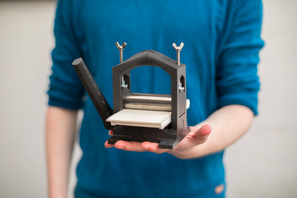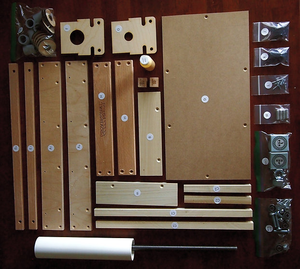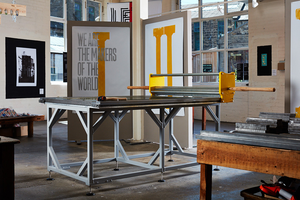State-of-the-Art
Current explorations of letterpress and other analogue printing techniques within a post-digital or hybrid design process are far-reaching and encompass several realities. Usually within educational contexts — schools and colleges —, or promoted by non-profit organizations or associations — eg. Oficina do cego —, these initiatives focus on different purposes such the revival and maintenance of a traditional craft, introduction to slow analogue hand-operated techniques (in opposition to the current fast digital machine based digital design, or as a purpose to develop a full-encompassing production process (ranging from the ideation to distribution phases, emphasizing the design and production).
Several national and international schools — eg. EASR, or LCA — still maintain their traditional workshops. Others seek to equip themselves with a mix of printing equipments to facilitate this. There are, nonetheless, other initiatives that seek to provide a way for individuals and institutions that have not the financial or environmental means to accomodate this kind of investment/equipment. These initiative focus on the digital fabrication of manual proof presses that can be assembled by means of currently available fabrication tools such as 3D printers, or lasercutters. This section focuses identifying and analysing these projects or initiatives and their creations: the provisional proof presses
Open Press
The Open Press letterpress printer was created in 2018 by Martin Schneider and Dominik Schmitz, two designers from Cologne, Germany. It is very small in size, can be 3D printed (in polymer) and is affordable. The print plans can be downloaded for free or the printer can be bought ready to use for whatever the buyer wants to give.
Thanks to its great portability the Open Press can be used to print whenever and wherever you want. It can print all sorts of things in the small size that it holds (business cards, greetings cards, small works of art) or print something larger through printing by modules (many small prints).
Its main aim is to make printing accessible to as many people as possible, thanks to its ease of transport, low price, and autonomy in the production of the printer itself. By using Open Press you can join a community of thousands of letterpress enthusiasts and share knowledge and creativity.
Open Press' biggest inspirations for XT_Press are the idea of autonomously producing a printer at an affordable value, and that through the free download of 3D printing plans can be assembled anywhere in the world and by anyone, but mainly among the student community. The wooden parts of the XT_Press can be cut out on a laser printer and combined with the other parts (plastic pipes, bearings and screws). As with the Open Press, the only requirement is access to basic materials.
F-Press
In 2019 Tom Boulton in Sussex created the Franken-Press (predecessor to the F-Press) named so because it was made from bits of scrap metal. In 2020 Covid 19 came along and with it the impossibility of running face-to-face workshops. For this reason and for personal issues, the motivation arose to create a new version of the Franken-Press that people could use at home in a practical way. The F-Press was created with the aim of being lightweight and portable, which allows people to do letterpress printing at home, thus providing an alternative to the traditional machines, which are usually heavier and bulky. The parts that make up the F-Press were created using 3D printing and CNC machines. The F-press is sold as a kit and, once assembled, weighs around 4 kg. Its printable area makes it possible to create A4 prints, and it can combine linoleum and letterpress printing. The great popularity of the F-Press made it possible to carry out workshops online, anywhere and by anyone, with the guidance of a teacher at a distance. The initial goal has been fully achieved, but its creator Tom Boulton intends to use the additional funding to continue exploring educational and creative solutions, both on a software and hardware level. He also plans to create a new wood printing press, but the main aim is to get this equipment to people who have never had the chance to print before. Above all Tom Boulton wants to involve future generations in printing, developing as an artist and educator.
The XT_Press, like the F-Press, is intended to be a desktop printer that can be used anywhere, by anyone. But in the case of the XT_Press there will be free sharing of the plans for printing the parts that make it up.
https://www.instagram.com/typetomdotcom/
https://www.crowdfunder.co.uk/p/lets-get-printing-f-press
https://www.thisiscolossal.com/2021/01/tabletop-printing-press/
TIMOS
Another artefact related to letterpress technology is the TIMOS modular typographic kit, which resulted from Ângelo Gonçalves' master's degree project at the School of Media Arts and Design in Porto. This kit explores the traditional printing technique based on modularity, using two tools: the stencil ruler and a set of movable type. TIMOS allows you to create and explore your own visual grammar, using the stencil ruler and an auxiliary sheet. Starting from initial sketches and through the combination of the TIMOS movable types it is possible to create and print compositions.
TIMOS is a modular system that like the XT_Press can be used in educational contexts and non-profit organizations allowing to create visual compositions autonomously.
https://angelogoncalves.pt/timos-11et
Provisional press
The Provisional Press is a letterpress printer sold in kit form or already assembled, it was created by Steve Garst and his wife Liz in 2020. The print kits are manufactured in America by a small team. During the pandemic the original Provisional Press was redesigned - in conjunction with Scott Moore of Moore Wood Type - so that it could be marketed in kits to meet the needs of universities and their students forced to deal with social lockdown. The kit is centred on the creation of an affordable printing press, made with high quality parts that will last for thousands of prints if used correctly. Although the original press has been reconfigured the original aim of creating an affordable desktop press has been maintained. The Provisional Press does not intend to replace the more traditional printers, but mainly to allow people to have access to print more economically and anywhere.
The XT_Press as well as the Provisional Press intends to be a table printer and have an accessible cost, having the user - in the case of the XT_Press -, only to spend money with the materials needed for printing and assembly.
https://www.provisionalpress.com
The people powered press
Built in 2019 by JKN OilTools in Batley, the People Powered Press is the largest letterpress printer of its kind in the world. Designed by design studio Split, the People Powered Press was made last year as part of their project and book These Northern Types. It is used by various groups of people, through writing and printing workshops, to make large format prints - with the purpose of amplifying the voices and words of local community groups - which are then displayed locally in both indoor and outdoor spaces. For its large size it was recognised by the Guinness Book of Records on 15 April 2019 as the world's largest letterpress printer. The first type made for this printer is called Graft, in honour of the JKN OilTools team, and was cut out of 720pt steel, accompanied by a set of giant numerals reaching 3480pt.
XT_Press shares with The People Powered Press a desire to work with and raise the profile of local communities and groups by using the printer to manufacture and visually communicate impactful messages.
Prixel
Similar to the XT_Press. It is based on digital manufacturing (home-made) in silicone. It was designed by Brandon Gamm and is the result of ten years of collecting small movable type and a passion for prototyping. To print, you just need to place the letters and shapes on the grid, apply some ink, place a sheet and apply pressure. Each kit included two setup montage that allow you to keep one composition while creating another. Prixel's modules are soft enough to print by hand like a rubber stamp, but rearrangeable like a traditional letterpress system. The colours of the silicone parts are colour coded which not only gives them a radical look, but is also practical when storing the parts. This system of modular pieces allows a great composition flexibility. Some pieces have geometric shapes and lines that allow you to create the most varied elements, from figurative to abstract.
Desktop Printing Press
The Desktop Printing Press grew out of wondering what a modern version of Gutenberg's classic invention of the printing press would look like. Early ideas ran through a mini desktop version that used flash cards. Although it was possible to cut the wooden pieces with a laser cutter, MU5ICI4N cut all the pieces by hand. Laser cutting would greatly improve the overall quality of the printer as with the XT_Press. Instructions for assembling this printer are on the instructables page with the goal of empowering others to build it. XT_Press shares with Desktop Printing Press this desire to give the general public the ability to print autonomously.
Miniature Printing Press
The Miniature Printing Press was created by Costatino Montanari inspired by the "Printing Revolution" in Europe. 3D technology allowed him to create his own miniature printer. Although the design of his printer is not completely original, the 3D version is. The Miniature Printing Press can print on pages of paper up to the size of a business card, making it possible to make personalised business cards. The maximum printing area is 85 x 55 mm. It works simply by passing a roll of ink onto the printing plate inside the printer. Then, place the paper in contact with the printing plate, insert the soap piece and press the two levers. These will exert force on the various layers allowing the ink from the printing plate to flow onto the paper. Like the XT_Press the Printing Press requires some parts that are manufactured to order and others that are purchased to connect the various structures together. This printer can be printed on any 3D printer with a print area of at least 200mm x 200mm.





